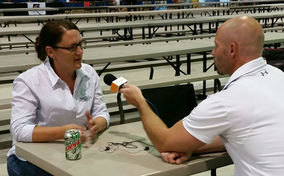 The
Cottonwood Cattle Producers hosted the Minnesota State Cattlemen's
Association’s summer tour and trade show Tuesday, July 10 in the Windom
and surrounding area. “It's a good opportunity to show how we do things in our
part of the state and use the resources that we have,” Cottonwood County Cattle
Producer board member and tour coordinator Jamey Hochstein told the Worthington
Daily Globe. “It’s also good to show innovative things that producers are
doing.” Photo: MSCA executive director Ashley Kohls is
interviewed on radio. Tour stops included:
- Graff Feedlots LLC, northeast
of Jeffers: Cow-calf pasture operated by Troy and Hilary Paplow and Glen
and ValRee Graff that implements rotational grazing and cover crops.
- Minnesota Supreme Feeders,
south of Lamberton: Modern feedlot owned by Warren, Maxine and Mark
Pankonin.
- J&S Grazing, west of
Windom: Stocker pasture operated by Jeff and Scott Fredin.
- Extended Ag Service, Lakefield:
Agriculture service provider operated by Jim, Andy and Matt Nesseth that
offers scouting, research and advice.
- O’Connor Farms, southwest of
Lakefield: Vintage feedlot with improvements to meet demands of
today’s production expectations and market owned by Dan O’Connor.
- Marlin and Kelly Piotter
cow-calf pasture, southeast of Windom: Rotational grazing pasture.
The event included a trade show featuring 56 indoor and 12
outdoor ag-related vendors at the Cottonwood County Fairgrounds in
Windom. The Cottonwood Cattle Producers last hosted the event in 2008, and
also hosted in 1998. The 2019 Summer Beef Tour will be July 9 in the Morris
area.
Back to top
|
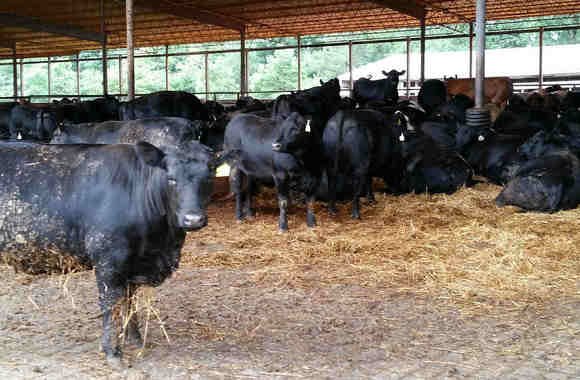 Black angus cattle at Minnesota Supreme Feeders south of Lamberton
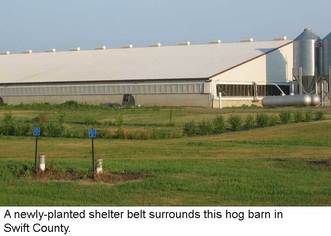
From UM Extension Swine Newsletter, July 2018: Want to
know more about your environmental footprint? Get additional information
about operational costs? University of Minnesota Extension specialist, Erin
Cortus and Extension Educators, Diane DeWitte, Jason Ertl and Sarah Schieck
are looking to work with producers in confidentially assessing their own
operations using The Pig Production Environmental Footprint Calculator - a
tool developed with support from and maintained by the National Pork Board.
Pork
producers have made tremendous strides in productivity - as measures like
pigs weaned per sow and live weight marketed per ton of feed and per pig
space continue to improve. These measures of productivity serve the industry
well, but consumers increasingly want to hear more about how the pork they
enjoy eating makes productive use of limited resources, like energy, water
and land. An 'environmental footprint' flips the point of view around
to consider how much of a limited resource is used to produce a live pig or a
pound of pork. Read
more.
Back to top
|
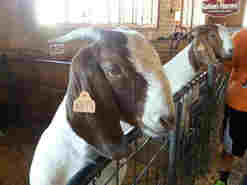
Board of Animal Health news release, 7/2/18: The Minnesota Board of Animal Health reminds livestock
owners to review their responsibilities before exhibiting animals at
their county fair or other events this summer. Animal health is a
shared responsibility and is part of overall public health, especially
at events that bring people and animals together.
In general, animals should have official identification
and be free from infectious, contagious or communicable disease,
including ringworm and warts. Any animals coming to Minnesota from
another state need to be inspected by a veterinarian before movement,
and move with a Certificate of Veterinary Inspection (CVI) and permit
(if required) filed with the Board of Animal Health. Proper
identification and records allow for a quick and thorough response to
minimize spread of animal disease.
Not all forms of identification are approved by the Board
and acceptable forms of official identification vary by species. You
can find a breakdown of acceptable official identification on our
website, www.mn.gov/bah/official-id.
The Board’s website is also a great resource for species specific
guidelines and requirements for exhibiting animals in Minnesota. Check
out the exhibitions page for more details: www.mn.gov/bah/exhibitions.
Owners should be aware of any specific rules or
expectations of the fair or event they’re attending. Additional
questions or concerns regarding exhibition of livestock in Minnesota
can be directed to the exhibition manager, official veterinarian or by
calling the Board at 651-201-6826.
Back to top
|
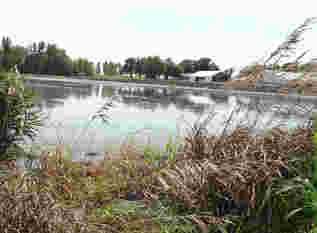
Continued summer
rainfall in southern Minnesota finds some livestock producers scrambling
to stem overflow from livestock manure storage basins. Pollution problems
include overflowing manure and wastewater storage structures and releases
from underground and above-ground storage tanks as well as open feedlots
located in floodplains or in sensitive areas where runoff can enter surface
waters. Photo: Overflowing cattle manure storage basin from recent heavy
rains in southwest Minnesota.
Farmers must call the Minnesota Duty Officer immediately at
(800) 422-0798 (calls answered 24/7) if their manure-storage facilities
overflow, if manure enters surface waters or if their manure-storage
structure is inundated by floodwaters. If their manure-storage
facilities are in danger of overflowing, farmers can contact the MPCA at
(800) 657-3864 or (651) 296-6300 (during regular business hours) and ask for
a feedlot staff person. Farmers in feedlot delegated counties also may
contact county feedlot staff. NPDES and SDS permit holders experiencing a
discharge must submit the 5-day discharge report and notify the agency
when the level encroaches on the freeboard.
To reduce the likelihood of an overflow, feedlot operators are
encouraged to divert water from manure-storage facilities if
possible. Manure stockpiles located in areas that could flood should be
removed immediately.
While we can’t control weather, planning ahead helps to better
deal with the impact of bad weather on manure management and land
application. A little more investment in storage, conservation practices, and
planning can be a very cost-effective form of insurance. It also reduces the
risk of economic loss of nutrients from surface-applied manure without
incorporation. Farmers with open feedlots should scrape-and-haul weekly
if possible.
For more information about flooding and the environmental
problems it can create, visit the minimizing flood risk page on the MPCA
website. Factsheet: Managing manure storage and land application during adverse
weather conditions.
Back to top
|
The MPCA feedlot program has clarified when a gilt should be
assigned a 0.3 or 0.4 animal unit (AU) value. The need for this clarification results from a change in the industry from operating stand-alone gilt facilities to
now incorporating gilt developing/acclimation components as part of breeding/gestation facilities. Historically, all animals at breeding/gestation facilities were considered as breeding stock and typically assigned a 0.4 AU value. A 0.3 AU value will now be used
for facilities (barns or an area of a larger barn) that house gilts prior to breeding. Any gilts
housed in crates, pens, etc. where insemination takes place will continue to be
assigned a 0.4 AU value. All bred gilts shall be assigned a 0.4 AU value
regardless of the weight of the animal. This clarification is consistent with Minnesota’s feedlot rules (Minn.
R. ch. 7020): One head of swine over 300 pounds is given a 0.4 AU factor and one
head of swine between 55 pounds and 300 pounds is given a 0.3 AU value. Gilts
prior to breeding weigh approximately 250-275 pounds, whereas a bred gilt is
expected to exceed 300 pounds at the time of farrowing.
Back to top
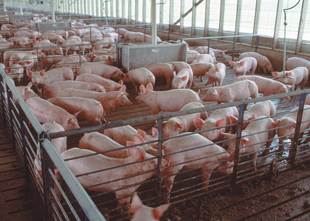
If foot and mouth disease (FMD), classical swine fever (CSF), or African swine fever (ASF) is found in United States livestock, regulatory officials will limit the movement of animals and animal products to try and control the spread of these very contagious animal diseases.
The Secure Pork Supply (SPS) Continuity of Business Plan provides opportunities to voluntarily prepare before an outbreak. This will better position pork premises with animals that have no evidence of infection to:
- Move animals to processing or another pork production premises under a movement permit issued by Regulatory Officials, and
- Maintain business continuity for the swine industry, including producers, haulers, and packers during an FMD, CSF, and ASF outbreak.
The plan requires a
written enhanced biosecurity plan for each site. It is the
producer’s responsibility to protect his or her herd by keeping the disease
off the farm. It is the regulatory official’s responsibility to protect the
U.S. herd by keeping the disease from spreading.
Dr. Dave Wright is the Minnesota coordinator for the Secure
Pork Supply Plan. Contact him at wright2me.dave@gmail.com or 763-242-7535 if you need
assistance in the participation process or would like supplemental
information about the three basic concepts of the Secure Pork Supply Plan:
Traceability and Movement Management, Enhanced Biosecurity, and Foreign
Animal Disease Training and Response.
Back to top
|
- Cory Salzl has resigned as Meeker County feedlot officer.
- Walter Jordan is leaving the feedlot staff in the Mankato MPCA office for a job with J.R. Simplot in Grand Forks, where has worked before coming to the MPCA.
- MPCA feedlot program position openings will be posted in the near future for Mankato and
Rochester.
- A student worker is starting in St. Paul MPCA office to assist with the backlog of entering feedlot registration
data into the TEMPO database. LesLee Jackson is currently a
student at the U of M pursuing a BS in Environmental Science Policy and
Management. She has held student worker jobs at the U of M, most
recently acting as a recycling coordinator for the agricultural plastic generated from
multiple departments at the U of M campuses, and Revolution Plastics, an ag plastic recycler.
Back to top
SDSU to host tour of S.D. heifer development and feedlot facility Aug. 9
Tristate Livestock News, 6/29/18
MPCA sets up air monitoring at Goodhue County hog farm
Rochester Post-Bulletin, 7/5/18
Hog farm opponents encouraged by meeting with governor
Rochester Post-Bulletin, 7/5/18
Fillmore County backs EIS request for proposed feedlot
Fillmore County Journal, 7/9/18
Minnesota's livestock producers and veterinarians should be on the lookout for seasonal diseases like anthrax
Board of Animal Health news release, 7/17/18
Back to top
Aug. 6-9: Minnesota Farm Fest, Gilfillan Farm, Redwood County.
Aug.
15-16: North American Manure Expo, Brookings, SD.
Aug. 16: Drainage water management, SWROC, Lamberton.
Aug. 23-Sept. 3: Minnesota State Fair.
Sept. 25: Ag and Animal Science Conference, MinnWest
Technology, Willmar.
Oct. 18-21: Minnesota Beef Expo, Minnesota State Fairgrounds.
Back to top
The
MPCA Feedlot Update welcomes news from partners about, projects, people, and
upcoming events. Email submissions to forrest.peterson@state.mn.us.
Past issues of Feedlot Update are available on the feedlot program publications webpage.
|